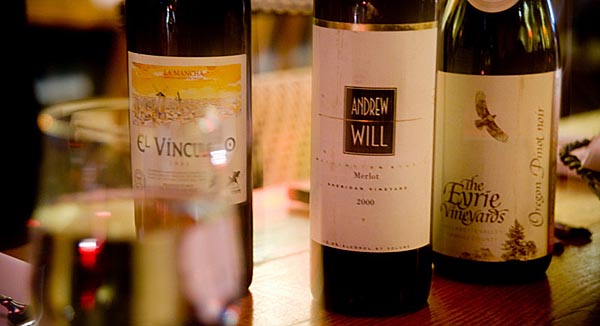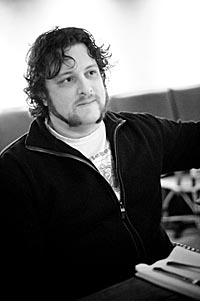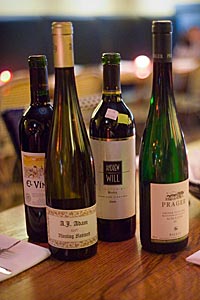
On a recent Friday night, the center table at Cave Vin contained the following:
- Glasses, plates, forks, and knives
- Sauteed olives with herbs, frog legs, sliced baguettes, and an order of steak tartare
- A bottle of excellent Swiss beer
- Nine or more bottles of vintage wine
The food, ably prepared as it was, was largely irrelevant, as was the delicious beer. The wine was the focus — an experiment was in progress.
Sitting at the table was Heavy Table editor James Norton, Gastro Non Grata creators and serious wine dorks Craig Drehmel and Jeff Mitchell, and wine distributor Bill Hooper.
The goal: Selling Norton, a lifelong oenophobe, on the appeal of the only spirituous beverage to earn an endorsement from the Talmud: “There is no true happiness without wine.”
JAMES NORTON: I’ve never been a wine fan. I guess the thing that always turned me off was the depth of trivia and/or serious knowledge surrounding the stuff — that it’s for experts only, and if you make a mistake, it’s usually an expensive one. There’s not a lot of fiscal room for blundering. Take beer for comparison — a $10 or $15 750ml bottle of beer is almost guaranteed to be good or downright excellent. It’s very difficult to screw up when you spend $50 or $60 on a bottle of Scotch that will likely last six months or longer before you sip it into oblivion. But wine? I’ve even had $10 glasses of it that were deeply unimpressive. My general experience with drinking wine has been some combination of feeling cheated and feeling like I suffer from some kind of personal failing for not “getting it.”

So what I was hoping you guys would be able to do, as professional wine distributors or vendors, was bring some wines to the table that would knock my socks off in the same way that Allagash White bowled me over when I tried it back in 1999, or the same way Highland Park 18 impressed me this year. I was looking for that “ah-ha!” moment.
What are some of the more intriguing things you guys brought to the table, and what was your theory in terms of selecting bottles for this challenge?

CRAIG DREHMEL: Well James, if all you’re ever going to drink are $10 bottles of wine, you probably won’t walk away with any newfound wine appreciation. I’m not saying there aren’t any good $10 wines, but there are many bad ones. Luckily most of the wines we have here are very old and mostly on the expensive side. I figured since you’ve had your share of crappy wine, that I’d dig down in the cellar for some fun, weird, more interesting wines that have a few years on them.
Wine is a daunting beverage — I didn’t answer the phone at my first liquor store job for three months because I was so afraid I’d sound like an idiot. Once I finally got past the fact I’m going to sound like an idiot anyway, I just dove in head first and started drinking and reading and drinking and reading. It didn’t take me long to realize I didn’t have the time or money to truly understand the great wines of the world in any set amount of time, but I’m fairly obsessive and like to think I’m furthering my alcoholic education and spending my tuition in numerous liquor stores around town.
Most serious wine lovers don’t have a favorite wine, since there are so many varietals and regions out there, but they probably have their own personal “magic bottle.. The first wine they tasted when they realized wine can be more than just fermented grape juice — that it can take you places, show you texture, nuance, balance and flip that switch on your palate that sends it into overdrive. If none of these bottles are magic for you, I at least hope you want to keep on looking for it.
NORTON: The problem I’ve had with wine in the past is that it tends to be one-dimensional, or possibly two-dimensional at best. Huge hits of fruit, often far too much sweetness, very little to think about when you’re through with it. More expensive bottles have been more refined about their approach, but I’m always left thinking: Damn, I could really go for a Scotch right about now. Sometimes it’s a question of stuff tasting anemic, rather than delicate, if that makes sense.
Some of these bottles we’ve got here, however, are really fascinating. Take this ’98 Truchard Pinot Noir, for example. I think you said “tobacco,” earlier about this. Completely. That’s precisely what’s kicking around in there… how the hell did that happen? There’s this sharpness up front and a funky, barnyard-y smoke to the body of the flavor — really wild stuff.
This is not a flavor I’m going to get bored with. I guess the thing I always wind up looking for in beer and Scotch — muskiness, depth, smokiness, peat, tartness, surprising finishes, deceptive noses — it’s totally there in wine, if you’re shopping for the right bottle.

DREHMEL: Well, you’re completely right, most wines out there are very one-dimensional with nothing but alcohol and one big Kool-Aid Man punching you in the face saying “Oh Yeah!” Technology is so good on some of these cheaper wines where that there’s not much change from vintage to vintage because of what’s happening in the winery. And it works, there are a lot of mediocre wines in horribly obnoxious packaging that always seem to sell.
I think the main problem stems in the fact that people tend to want to spend less on a bottle by calling it “everyday wine”; even I use the term. But let’s get serious here: I’m in the wine business and I don’t even drink wine on a daily basis anymore, only retail guys can do that. People should be doing themselves a favor and spend at least $15 on a bottle of wine, because it will have a better chance of being a wine that shows character, regionality, and it will usually just plain taste better than a cheaper wine.

Am I saying there are no good under $10 wines? Of course not. But those wines are few and far between. You won’t get bitten by the wine bug if your only experience with wine is a handle and a spigot. As for me, I’m really digging this 1999 El Vinculo from the master of disaster in Spain, it’s an Alejandro Fernandez tempranillo from La Mancha and has got the nose of a dirty pig that’s being pelted with black cherry pits. This stuff is amazing, too bad it’s my last bottle.
NORTON: You see, you say stuff like that — “too bad it’s my last bottle” — and you conjure up a lot of the magic surrounding wine that I’ve missed. This idea that each bottle is this special, almost individual thing. Not just something you can tap from a soda dispenser.
I like the El Vinculo — surprisingly gentle — but I think I like your description of it as much or more than the wine itself.
Personally, this stuff Bill brought, this 2001 Prager Gruner Veltliner from Austria, is blowing me away. This — along with the Truchard — is really selling me on wine overall, to be honest. You mentioned “gunflint,” and that’s exactly right. When I took my first sip, the first thing that hit me was a sense memory of Fourth of July as a kid — firing Roman candles at each other, setting whole rolls of caps on fire, blowing up stuffed animals with M-60s. There’s a white pepper thing going on as well, and a beautiful, subtle fruit quality to the wine as well. It’s dangerous.
Part of the thing is, I would have never found this by myself. Where are a couple excellent places to go around here to talk to someone and get a really good wine recommendation?
DREHMEL: The one thing people need to understand is that wine on a shelf will not talk to you, but people will. I’ve seen customers wander a store for 45 minutes, staring at random bottles of wine for minutes at a time, refusing all reccomendations and then walk up with a lone bottle of animal label wine. All I can do is shake my head.
I guess the best thing you can do is find yourself a certified dork, and Dave Kuennan of Brightwines.com in North St. Paul next to the snowman is one of the bigger dorks around. It’s a bit of a drive but he carries about 250 wines that run all regions and price points, and there’s not a bad one in the bunch. He knows his stuff and makes wine approachable for all of his customers, just don’t get him started on kraftwerk.
Solo Vino in St. Paul and Zipp’s in Minnneapolis always have a good selection and there are always the usual suspects Haskell’s, Surdyk’s, Cellars. There are actually a lot of good wine stores in town — the best advice I could give you is to go to stores where employees actually ask if you would like any help finding anything and engage them from there. It’s pretty easy to tell if someone’s working for the employee discount the right or wrong way.
NORTON: Well, I have to hand it to you — I totally understand the appeal of wine at this point, and even — to a point — actually sympathize with it. It’s magic in a bottle — this volatile, complicated, fleeting little moment of discovery and mystery. Try five, and you want to try 25 more; try 25 more, and I guess that’s how people become wine fanatics.
Craig, Bill, Jeff — you guys have all been great. And your wine — that’s been great, too. Cheers and thank you!

But for those of us dying of curiosity, what was the beer?